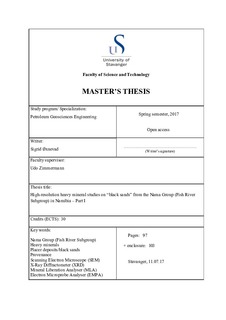| dc.contributor.advisor | Zimmermann, Udo | |
| dc.contributor.author | Øxnevad, Sigrid | |
| dc.coverage.spatial | Namibia | nb_NO |
| dc.date.accessioned | 2017-11-07T09:16:39Z | |
| dc.date.available | 2017-11-07T09:16:39Z | |
| dc.date.issued | 2017-07 | |
| dc.identifier.uri | http://hdl.handle.net/11250/2464487 | |
| dc.description | Master's thesis in Petroleum Geosciences Engineering | nb_NO |
| dc.description.abstract | A detailed high-resolution study is applied on selected samples to decipher the provenance for these deposits. The samples analysed in the project are placer deposits (“black sands”) from the Nama Group (Fish River Subgroup) in Namibia. The samples come from heavy mineral layers in red sandstones from the Rosenhof Mb (Gross Aub Fm) and the Haribes Mb (Nababis Fm). Heavy minerals in the samples are identified and quantified based on results from several analytical methods: Field Emission Scanning Electron Microscopy (FE-SEM) with Energy Dispersive Spectroscopy (EDS) detector, X-Ray Diffractometer (XRD), Mineral Liberation Analyser (MLA), and Electron Microprobe Analyser (EMPA). All samples contain chamosite, amphibole, tourmaline, garnet (almandine and grossular), magnetite, ilmenite, rutile, titanite, zircon and apatite. Grain shape, sorting and particle size distributions indicate that the sediments were accumulated in a river, and the energy of the water flow caused a selective settling of the heavy minerals based on grain size and grain density. The main differences between the samples is that the one from the Haribes Mb contains larger amounts of grossular and tourmaline, and less amounts of almandine, compared to the ones from the Rosenhof Mb. Also the grains in the samples from the Haribes Mb have a smaller grain size than the samples from the Rosenhof Mb, which means that they have lower grain settling velocities. The chemical composition of the heavy minerals indicates that the sediments derived from several provenances. Most almandines are interpreted to derive from metasediments (including amphibolite facies), from high-grade metamorphic rocks or acidic to intermediate gneisses and granites. Some of the almandines probably derived from high- grade mafic and ultramafic gneisses, and the grossular grains from contact or thermally metamorphosed calcareous sediments or associated metasomatic skarns. Titanites are interpreted to derive from mafic igneous source rocks, and tourmalines from Li-poor granitoid, pegmatite or aplite, and aluminous, Ca-poor metapelite or metapsammite. The detrital heavy mineral records of the deposits of the Fish River Subgroup indicate a complex source region composed of high-grade metamorphic, felsic and mafic rocks. The heavy mineral grains are generally not well rounded, they are probably river deposits, and therefore they are not likely to have been transported hundreds of kilometers. The source rocks appears to be close. The Namaqua Belt is located next to and south of the sampling area and consists of mafic and felsic rocks metamorphosed to greenschist or amphibolite facies. The Namaqua Belt is interpreted to be the main source area for the heavy minerals in the samples. | nb_NO |
| dc.language.iso | eng | nb_NO |
| dc.publisher | University of Stavanger, Norway | nb_NO |
| dc.relation.ispartofseries | Masteroppgave/UIS-TN-IPT/2017; | |
| dc.rights | Navngivelse 4.0 Internasjonal | * |
| dc.rights.uri | http://creativecommons.org/licenses/by/4.0/deed.no | * |
| dc.subject | Nama Group (Fish River Subgroup) | nb_NO |
| dc.subject | Scanning Electron Microscope (SEM) | nb_NO |
| dc.subject | X-Ray Diffractometer (XRD) | nb_NO |
| dc.subject | Mineral Liberation Analyser (MLA) | nb_NO |
| dc.subject | Electron Microprobe Analyser (EMPA) | nb_NO |
| dc.subject | heavy minerals | nb_NO |
| dc.subject | placer deposits/black sands | nb_NO |
| dc.subject | provenance | nb_NO |
| dc.subject | petroleumsgeologi | nb_NO |
| dc.subject | petroeleum geosciences | nb_NO |
| dc.title | High-resolution heavy mineral studies on “black sands” from the Nama Group (Fish River Subgroup) in Namibia – Part I | nb_NO |
| dc.type | Master thesis | nb_NO |
| dc.subject.nsi | VDP::Teknologi: 500::Berg‑ og petroleumsfag: 510::Geoteknikk: 513 | nb_NO |
| dc.subject.nsi | VDP::Matematikk og Naturvitenskap: 400::Geofag: 450::Petroleumsgeologi og -geofysikk: 464 | nb_NO |
| dc.source.pagenumber | 200 | nb_NO |

